Report on Krakatau (Indonesia) — January 2008
Bulletin of the Global Volcanism Network, vol. 33, no. 1 (January 2008)
Managing Editor: Richard Wunderman.
Krakatau (Indonesia) Repeated minor eruptions during October-November 2007
Please cite this report as:
Global Volcanism Program, 2008. Report on Krakatau (Indonesia) (Wunderman, R., ed.). Bulletin of the Global Volcanism Network, 33:1. Smithsonian Institution. https://doi.org/10.5479/si.GVP.BGVN200801-262000
Krakatau
Indonesia
6.1009°S, 105.4233°E; summit elev. 285 m
All times are local (unless otherwise noted)
During 23-26 October 2007, minor eruptions occurred at Anak Krakatau (BGVN 32:09), an island and active vent on the rim of the famous larger caldera whose name often is misspelled as "Krakatoa." This report continues coverage from late October through November 2007. The Center of Volcanology and Geological Hazard Mitigation (CVGHM) raised the Alert Level to 3 (on a scale of 1-4) for Krakatau on 26 October because of the presence of multiple gray plumes from the volcano and an increase in seismicity. Plumes rose to an altitude of ~ 1 km during 23-26 and 30 October. Villagers and tourists were advised not go within 3 km of the summit.
According to an Associated Press news article, "red-hot lava flares" from Anak Krakatau rose 500-700 m above the S crater on 6 November. Multiple ash clouds were also observed. On 9 November, CVGHM officials in Bandung, West Java, conducted seismic and visual monitoring. Officials said, that on that day there were 182 eruptions coupled with 11 volcanic earthquakes, 54 shallow volcanic shocks, eight deep volcanic tremors and 44 shallower tremors. The volcano spewed "smoke" 29 times. On 13-14 November, as reported by CVGHM, lava flows and incandescent rocks traveled 400 m down the flanks.
As reported by VolcanoDiscovery's Tom Pfeiffer, who visited there from 21-26 November, emissions were relatively constant. He noted that all activity occurred from the newly formed crater on the upper S flank just below the old summit crater (figure 18). On 21 November, the new crater had an oval shape, approximately 50 x 70 m. Dense, dark brown, billowing ash clouds escaped in pulses from the crater at near-constant intervals of about 2 minutes, rising typically 100-200 m above the crater and drifting E. A few blocks were ejected along with the ash clouds (figure 19).
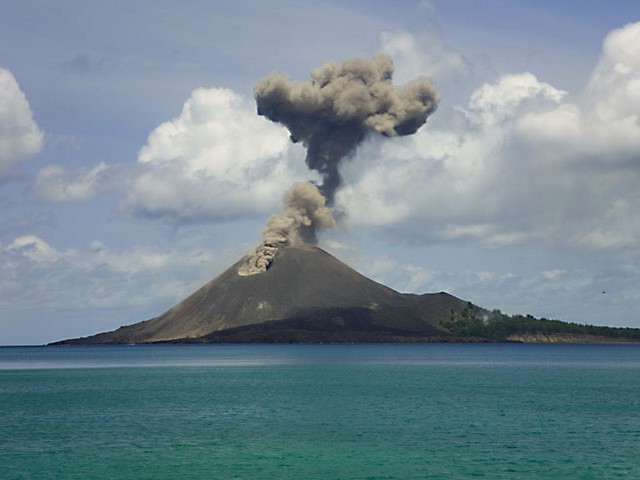 |
Figure 18. A sudden explosion ejecting rocks and ash on the S flank of the old Anak Krakatau crater on 22 November, 2007. Courtesy Tom Pfeiffer of Volcano Discovery. |
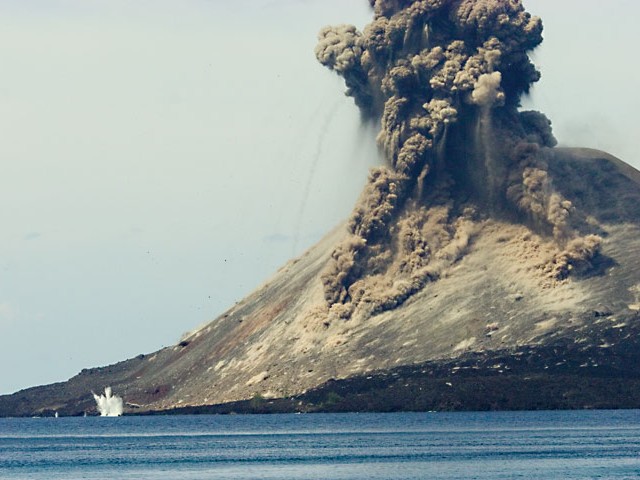 |
Figure 19. Ballistic blocks land all over the cone of Anak Krakatau where the impacts stir up dust on 22 November 2007. A few also flew as far as the sea. Courtesy Tom Pfeiffer of Volcano Discovery. |
Pfeiffer also reported that at more irregular intervals, about 10-30 min apart, more violent, small vulcanian explosions interrupted the weaker ash venting events. The more violent explosions consisted of a sudden spray of mostly solid rocks and few incandescent scoria, followed by more powerful and turbulent ash plumes that rose up to 1 km above the crater (figure 20). Generally, these vulcanian explosions occurred after a slightly longer quiet period and, in most cases, the length of the quiet period correlated with the force of the explosion.
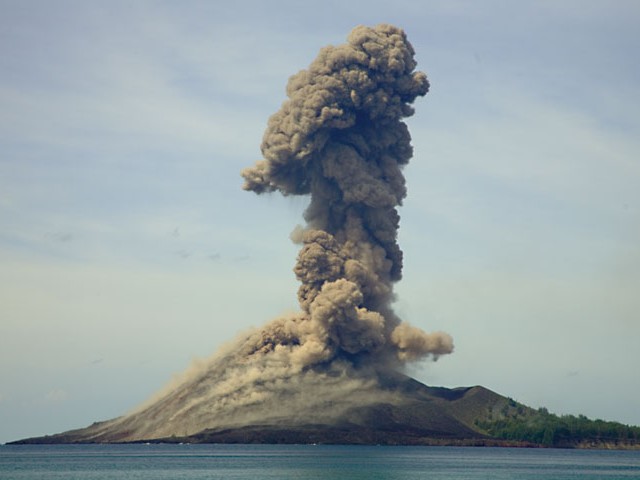 |
Figure 20. Eruption plume at Anak Krakatau rising to ~ 1 km on 23 November 2007. Courtesy Tom Pfeiffer of Volcano Discovery. |
Pfeiffer noted that several more powerful explosions occurred at intervals of approximately 16-24 hours. The strongest, on 21-22 November, showered the whole island with incandescent blocks, ignited bush fires, and produced a very loud cannon-shot noise that rattled windows on the W coast of Java, 40 km away (figure 21).
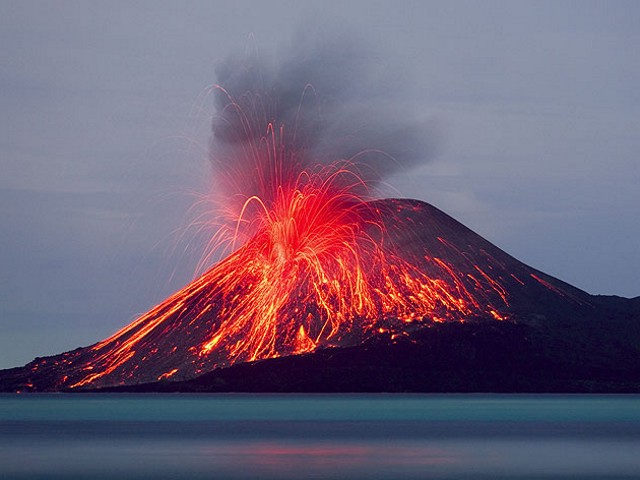 |
Figure 21. On the evening of 21 November 2007, a powerful blast throws bombs and blocks all over the old cone of Anak Krakatau. Courtesy Tom Pfeiffer of Volcano Discovery. |
Other, unusually large blasts occurred at around 0200 on 21 November and at around 0900 and 1320 on 23 November (figure 22). Early on 23 November, activity became more ash-rich and the vigor of the individual events increased slightly over the next two days. The pace of single explosions stayed at near-constant intervals of about 2 minutes. During 24-25 November, ash plumes typically rose to over 1 km above the crater and were easily visible from the W coast of Java. Based on a pilot report, on 24 November, the Darwin Volcanic Ash Advisory Center noted that an ash plume rose to an altitude of 3 km and drifted NE.
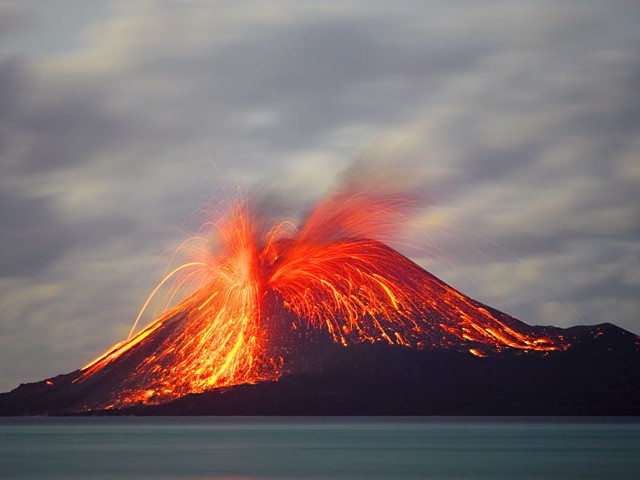 |
Figure 22. Another very powerful blast occurs at around 0300 on 24 November 2007. Incandescent blocks reach the lower western flanks of the island. Courtesy Tom Pfeiffer of Volcano Discovery. |
Based on the University of Hawaii's Institute of Geophysics and Planetology (HIGP) Thermal Alerts System MODVOLC analysis of MODIS (Moderate Resolution Imaging Spectroradiometer) satellite thermal anomaly data, occasional hot spots were identified by Terra or Aqua satellites. The thermal alerts occurred on twelve occasions between 27 October and 9 December 2007. Seven of these took place between 16 and 26 November 2007.
Geological Summary. The renowned Krakatau (frequently mis-named as Krakatoa) volcano lies in the Sunda Strait between Java and Sumatra. Collapse of an older edifice, perhaps in 416 or 535 CE, formed a 7-km-wide caldera. Remnants of that volcano are preserved in Verlaten and Lang Islands; subsequently the Rakata, Danan, and Perbuwatan cones were formed, coalescing to create the pre-1883 Krakatau Island. Caldera collapse during the catastrophic 1883 eruption destroyed Danan and Perbuwatan, and left only a remnant of Rakata. This eruption caused more than 36,000 fatalities, most as a result of tsunamis that swept the adjacent coastlines of Sumatra and Java. Pyroclastic surges traveled 40 km across the Sunda Strait and reached the Sumatra coast. After a quiescence of less than a half century, the post-collapse cone of Anak Krakatau (Child of Krakatau) was constructed within the 1883 caldera at a point between the former Danan and Perbuwatan cones. Anak Krakatau has been the site of frequent eruptions since 1927.
Information Contacts: Center of Volcanology and Geological Hazard Mitigation (CVGHM), Saut Simatupang, 57, Bandung 40122, Indonesia (URL: http://vsi.esdm.go.id/); Darwin Volcanic Ash Advisory Center, Bureau of Meteorology, Australia (URL: http://www.bom.gov.au/info/vac); Tom Pfeiffer, Volcano Discovery (URL: http://www.decadevolcano.net/, http://www.volcanodiscovery.com/volcano-tours/krakatau/photos.html); Associated Press (URL: http://www.ap.org/).

